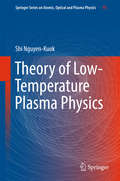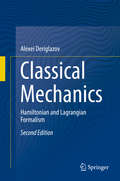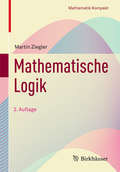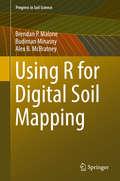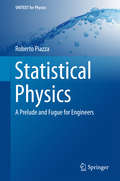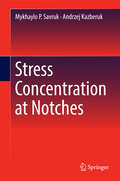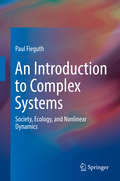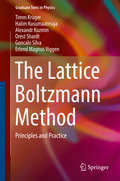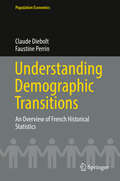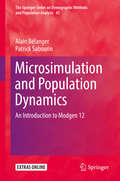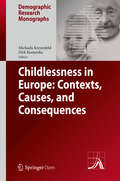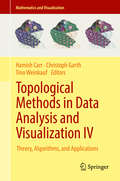- Table View
- List View
Theory of Low-Temperature Plasma Physics (Springer Series on Atomic, Optical, and Plasma Physics #95)
by Shi Nguyen-KuokThis book offers the reader an overview of the basic approaches to the theoretical description of low-temperature plasmas, covering numerical methods, mathematical models and modeling techniques. The main methods of calculating the cross sections of plasma particle interaction and the solution of the kinetic Boltzmann equation for determining the transport coefficients of the plasma are also presented. The results of calculations of thermodynamic properties, transport coefficients, the equilibrium particle-interaction cross sections and two-temperature plasmas are also discussed. Later chapters consider applications, and the results of simulation and calculation of plasma parameters in induction and arc plasma torches are presented. The complex physical processes in high-frequency plasmas and arc plasmas, the internal and external parameters of plasma torches, near-electrode processes, heat transfer, the flow of solid particles in plasmas and other phenomena are considered. The book is intended for professionals involved in the theoretical study of low-temperature plasmas and the design of plasma torches, and will be useful for advanced students in related areas.
Issues in the Use of Neural Networks in Information Retrieval (Studies in Computational Intelligence #661)
by Iuliana F. IatanThis book highlights the ability of neural networks (NNs) to be excellent pattern matchers and their importance in information retrieval (IR), which is based on index term matching. The book defines a new NN-based method for learning image similarity and describes how to use fuzzy Gaussian neural networks to predict personality.It introduces the fuzzy Clifford Gaussian network, and two concurrent neural models: (1) concurrent fuzzy nonlinear perceptron modules, and (2) concurrent fuzzy Gaussian neural network modules.Furthermore, it explains the design of a new model of fuzzy nonlinear perceptron based on alpha level sets and describes a recurrent fuzzy neural network model with a learning algorithm based on the improved particle swarm optimization method.
NEO 2015: Results of the Numerical and Evolutionary Optimization Workshop NEO 2015 held at September 23-25 2015 in Tijuana, Mexico (Studies in Computational Intelligence #663)
by Oliver Schütze Leonardo Trujillo Pierrick Legrand Yazmin MaldonadoThis volume comprises a selection of works presented at the Numerical and Evolutionary Optimization (NEO) workshop held in September 2015 in Tijuana, Mexico. The development of powerful search and optimization techniques is of great importance in today’s world that requires researchers and practitioners to tackle a growing number of challenging real-world problems. In particular, there are two well-established and widely known fields that are commonly applied in this area: (i) traditional numerical optimization techniques and (ii) comparatively recent bio-inspired heuristics. Both paradigms have their unique strengths and weaknesses, allowing them to solve some challenging problems while still failing in others. The goal of the NEO workshop series is to bring together people from these and related fields to discuss, compare and merge their complimentary perspectives in order to develop fast and reliable hybrid methods that maximize the strengths and minimize the weaknesses of the underlying paradigms. Through this effort, we believe that the NEO can promote the development of new techniques that are applicable to a broader class of problems. Moreover, NEO fosters the understanding and adequate treatment of real-world problems particularly in emerging fields that affect us all such as health care, smart cities, big data, among many others. The extended papers the NEO 2015 that comprise this book make a contribution to this goal.
How Systems Form and How Systems Break: A Beginner’s Guide for Studying the World (Studies in Systems, Decision and Control #72)
by Chiang H. RenOur world is composed of systems within systems—the machines we build, the information we share, the organizations we form, and elements of nature that surround us. Therefore, nearly every field of study and practice embodies behaviors stemming from system dynamics. Yet the study of systems has remained somewhat fragmented based on philosophies, methodologies, and intentions. Many methodologies for analyzing complex systems extend far beyond the traditional framework of deduction evaluation and may, thus, appear mysterious to the uninitiated. This book seeks to dispel the mysteries of systems analysis by holistically explaining the philosophies, methodologies, and intentions in the context of understanding how all types of systems in our world form and how these systems break. This presentation is made at the level of conceptual understanding, with plenty of figures but no mathematical formulas, for the beginning student and interested readers new to studying systems. Through the conceptual understanding provided, students are given a powerful capability to see the hidden behaviors and unexplained consequences in the world around us.
Sunspots and Non-Linear Dynamics: Essays in Honor of Jean-Michel Grandmont (Studies in Economic Theory #31)
by Kazuo Nishimura Alain Venditti Nicholas C. YannelisThis book presents the state-of-the-art in non-linear dynamics and sunspots. These two topics have been the core of an international conference on instability and public policies in a globalized world, organized at Aix-Marseille School of Economics and GREQAM in honor of Jean-Michel Grandmont. He has made significant contributions on general equilibrium theory, monetary theory, learning, aggregation, non-linear dynamics and sunspots. This book assembles contributions by Jean-Michel Grandmont's colleagues, students and friends that have been influenced by his works and that are at the frontier of research in this domain today.
Monte Carlo Methods for Radiation Transport: Fundamentals and Advanced Topics (Biological and Medical Physics, Biomedical Engineering)
by Oleg N. VassilievThis book is a guide to the use of Monte Carlo techniques in radiation transport. This topic is of great interest for medical physicists. Praised as a "gold standard" for accurate radiotherapy dose calculations, Monte Carlo has stimulated a high level of research activity that has produced thousands of papers within the past few years. The book is designed primarily to address the needs of an academically inclined medical physicist who wishes to learn the technique, as well as experienced users of standard Monte Carlo codes who wish to gain insight into the underlying mathematics of Monte Carlo algorithms. The book focuses on the fundamentals—giving full attention to and explaining the very basic concepts. It also includes advanced topics and covers recent advances such as transport of charged particles in magnetic fields and the grid-based solvers of the Boltzmann equation.
Classical Mechanics: Hamiltonian and Lagrangian Formalism
by Alexei DeriglazovThe revised edition of this advanced textbook provides the reader with a solid grounding in the formalism of classical mechanics, underlying a number of powerful mathematical methods that are widely used in modern theoretical and mathematical physics. It reviews the fundamentals of Lagrangian and Hamiltonian mechanics, and goes on to cover related topics such as canonical transformations, integral invariants, potential motion in geometric setting, symmetries, the Noether theorem and systems with constraints. While in some cases the formalism is developed beyond the traditional level adopted in the standard textbooks on classical mechanics, only elementary mathematical methods are used in the exposition of the material.New material for the revised edition includes additional sections on the Euler-Lagrange equation, the Cartan two-form in Lagrangian theory, and Newtonian equations of motion in context of general relativity. Also new for this edition is the inclusion of problem sets and solutions to aid in the understanding of the material presented.The mathematical constructions involved are explicitly described and explained, so the book is a good starting point for the student new to this field. Where possible, intuitive motivations are replaced by explicit proofs and direct computations, preserving the level of rigor that makes the book useful for more advanced students intending to work in one of the branches of the vast field of theoretical physics. To illustrate how classical-mechanics formalism works in other branches of theoretical physics, examples related to electrodynamics, as well as to relativistic and quantum mechanics, are included.
Mathematische Logik (Mathematik Kompakt)
by Martin ZieglerDieses Buch bietet eine Einführung in die verschiedenen Aspekte der mathematischen Logik. Nach dem Praedikatenkalkül und seinen Anwendungen auf die Anfänge der künstlichen Intelligenz stellt der Autor die Mengenlehre axiomatisch dar. Im dritten und vierten Teil führt er die Grundbegriffe der Berechenbarkeitstheorie und die Hierarchie der Teilmengen ein, um schließlich die Gödelschen Unvollständigkeitssätze zu beweisen. Dieser Band zeichnet sich durch einen klaren Schreibstil aus und enthält zahlreiche Übungsaufgaben.
Estimation and Control for Networked Systems with Packet Losses without Acknowledgement (Studies in Systems, Decision and Control #77)
by Hong Lin Hongye Su Peng Shi Zhan Shu Zheng-Guang WuThis book discusses recent advances in the estimation and control of networked systems with unacknowledged packet losses: systems usually known as user-datagram-protocol-like. It presents both the optimal and sub-optimal solutions in the form of algorithms, which are designed to be implemented easily by computer routines. It also provides MATLAB® routines for the key algorithms. It shows how these methods and algorithms can solve estimation and control problems effectively, and identifies potential research directions and ideas to help readers grasp the field more easily.The novel auxiliary estimator method, which is able to deal with estimators that consist of exponentially increasing terms, is developed to analyze the stability and convergence of the optimal estimator. The book also explores the structure and solvability of the optimal control, i.e. linear quadratic Gaussian control. It develops various sub-optimal but efficient solutions for estimation and control for industrial and practical applications, and analyzes their stability and performance.This is a valuable resource for researchers studying networked control systems, especially those related to non-TCP-like networks. The practicality of the ideas included makes it useful for engineers working with networked control.
Information Technology and Computational Physics (Advances in Intelligent Systems and Computing #462)
by Piotr Kulczycki László T. Kóczy Radko Mesiar Janusz KacprzykA broad spectrum of modern Information Technology (IT) tools, techniques, main developments and still open challenges is presented. Emphasis is on new research directions in various fields of science and technology that are related to data analysis, data mining, knowledge discovery, information retrieval, clustering and classification, decision making and decision support, control, computational mathematics and physics, to name a few. Applications in many relevant fields are presented, notably in telecommunication, social networks, recommender systems, fault detection, robotics, image analysis and recognition, electronics, etc. The methods used by the authors range from high level formal mathematical tools and techniques, through algorithmic and computational tools, to modern metaheuristics.
High Field Plasmonics (Springer Theses)
by Luca FedeliThis thesis describes pioneering research on the extension of plasmonics schemes to the regime of high-intensity lasers. By presenting a rich and balanced mix of experimentation, theory and simulation, it provides a comprehensive overview of the emerging field of high field plasmonics, including open issues and perspectives for future research. Combining specially designed targets and innovative materials with ultrashort, high-contrast laser pulses, the author experimentally demonstrates the effects of plasmon excitation on electron and ion emission. Lastly, the work investigates possible further developments with the help of numerical simulations, revealing the potential of plasmonics effects in the relativistic regime for advances in laser-driven sources of radiation, and for the manipulation of extreme light at the sub-micron scale.
Using R for Digital Soil Mapping (Progress in Soil Science)
by Brendan P. Malone Budiman Minasny Alex B. McBratneyThis book describes and provides many detailed examples of implementing Digital Soil Mapping (DSM) using R. The work adheres to Digital Soil Mapping theory, and presents a strong focus on how to apply it. DSM exercises are also included and cover procedures for handling and manipulating soil and spatial data in R. The book also introduces the basic concepts and practices for building spatial soil prediction functions, and then ultimately producing digital soil maps.
Quick Guide to Good Clinical Practice: How to Meet International Quality Standard in Clinical Research
by Cemal Cingi Nuray Bayar MulukThis brand-new book offers a reference guide to understanding and applying the rules for properly conducting clinical trials to meet the international quality standard – Good Clinical Practice – provided by the International Conference on Harmonization (ICH). The work offers an updated perspective on the clinical research landscape within the context of the clinical trial regulatory frameworks in Europe and the USA. In addition to providing a historical review and a detailed definition of GPC regulations, it includes step-by-step explanations of all the requirements that researchers should bear in mind when designing and performing new trials. Further topics covered include: ethics of clinical research; the drug development process and evolution of regulations; investigator and sponsor responsibilities; and clinical trial protocols.Written by clinicians for clinicians, the book represents a valuable read also for researchers, pharmacists and all professionals involved in applications to the ethic committees, whose approval is required for new clinical studies.
Theoretical Physics 4: Special Theory of Relativity
by Wolfgang NoltingDer Grundkurs Theoretische Physik deckt in 7 Bänden alle für das Diplom und für Bachelor/Master-Studiengänge maßgeblichen Gebiete ab. Jeder Band vermittelt das im jeweiligen Semester notwendige theoretisch-physikalische Rüstzeug. Übungsaufgaben mit ausführlichen Lösungen dienen der Vertiefung des Stoffs. Der 4. Band behandelt die Gebiete Thermodynamik und Relativitätstheorie. Für die Neuauflage wurde er grundlegend überarbeitet und um 24 Aufgaben ergänzt. Durch die zweifarbige Gestaltung ist der Stoff jetzt noch übersichtlicher gegliedert.
Visual-spatial Ability in STEM Education: Transforming Research into Practice
by Myint Swe KhineEach chapter in this book makes a unique contribution to the body of the literature and enhances the understanding of spatial ability and its influence on learning in the STEM disciplines. It addresses spatial abilities, ways to measure them as well as their impact and how they can affect learning subjects in scientific, technology and engineering domains. The volume deliberately covers a wide range perspectives from cognitive psychology, educational psychology, science, technology, engineering and mathematics, computer science, information technology disciplines to human development. Taking a broad view on the topic, chapters in the book discuss how to define spatial ability and its factors, the measurement of spatial ability and psychometric analyses, and educational strategies to improve spatial skills and their implications for science and technology education. The book thus provides an overview of current thinking about visual-spatial ability, spatial reasoning, and spatial skills.
A Journey Through Discrete Mathematics: A Tribute to Jiří Matoušek
by Martin Loebl Jaroslav Nešetřil Robin ThomasThis collection of high-quality articles in the field of combinatorics, geometry, algebraic topology and theoretical computer science is a tribute to Jiří Matoušek, who passed away prematurely in March 2015. It is a collaborative effort by his colleagues and friends, who have paid particular attention to clarity of exposition – something Jirka would have approved of. The original research articles, surveys and expository articles, written by leading experts in their respective fields, map Jiří Matoušek’s numerous areas of mathematical interest.
Analytical Mechanics (Undergraduate Lecture Notes in Physics)
by Carl S. HelrichThis advanced undergraduate textbook begins with the Lagrangian formulation of Analytical Mechanics and then passes directly to the Hamiltonian formulation and the canonical equations, with constraints incorporated through Lagrange multipliers. Hamilton's Principle and the canonical equations remain the basis of the remainder of the text.Topics considered for applications include small oscillations, motion in electric and magnetic fields, and rigid body dynamics. The Hamilton-Jacobi approach is developed with special attention to the canonical transformation in order to provide a smooth and logical transition into the study of complex and chaotic systems. Finally the text has a careful treatment of relativistic mechanics and the requirement of Lorentz invariance.The text is enriched with an outline of the history of mechanics, which particularly outlines the importance of the work of Euler, Lagrange, Hamilton and Jacobi.Numerous exercises with solutions support the exceptionally clear and concise treatment of Analytical Mechanics.
Statistical Physics: A Prelude and Fugue for Engineers (UNITEXT for Physics)
by Roberto PiazzaThis book, provides a general introduction to the ideas and methods of statistical mechanics with the principal aim of meeting the needs of Master’s students in chemical, mechanical, and materials science engineering. Extensive introductory information is presented on many general physics topics in which students in engineering are inadequately trained, ranging from the Hamiltonian formulation of classical mechanics to basic quantum mechanics, electromagnetic fields in matter, intermolecular forces, and transport phenomena. Since engineers should be able to apply physical concepts, the book also focuses on the practical applications of statistical physics to material science and to cutting-edge technologies, with brief but informative sections on, for example, interfacial properties, disperse systems, nucleation, magnetic materials, superfluidity, and ultralow temperature technologies. The book adopts a graded approach to learning, the opening four basic-level chapters being followed by advanced “starred” sections in which special topics are discussed. Its relatively informal style, including the use of musical metaphors to guide the reader through the text, will aid self-learning.
Stress Concentration at Notches
by Mykhaylo P. Savruk Andrzej KazberukThis book compiles solutions of linear theory of elasticity problems for isotropic and anisotropic bodies with sharp and rounded notches. It contains an overview of established and recent achievements, and presents the authors’ original solutions in the field considered with extensive discussion. The volume demonstrates through numerous, useful examples the effectiveness of singular integral equations for obtaining exact solutions of boundary problems of the theory of elasticity for bodies with cracks and notches. Incorporating analytical and numerical solutions of the problems of stress concentrations in solid bodies with crack-like defects, this volume is ideal for scientists and PhD students dealing with the problems of theory of elasticity and fracture mechanics.
An Introduction to Complex Systems: Society, Ecology, and Nonlinear Dynamics
by Paul FieguthThis undergraduate text explores a variety of large-scale phenomena - global warming, ice ages, water, poverty - and uses these case studies as a motivation to explore nonlinear dynamics, power-law statistics, and complex systems. Although the detailed mathematical descriptions of these topics can be challenging, the consequences of a system being nonlinear, power-law, or complex are in fact quite accessible. This book blends a tutorial approach to the mathematical aspects of complex systems together with a complementary narrative on the global/ecological/societal implications of such systems.Nearly all engineering undergraduate courses focus on mathematics and systems which are small scale, linear, and Gaussian. Unfortunately there is not a single large-scale ecological or social phenomenon that is scalar, linear, and Gaussian. This book offers students insights to better understand the large-scale problems facing the world and to realize that these cannot be solved by a single, narrow academic field or perspective. Instead, the book seeks to emphasize understanding, concepts, and ideas, in a way that is mathematically rigorous, so that the concepts do not feel vague, but not so technical that the mathematics get in the way. The book is intended for undergraduate students in a technical domain such as engineering, computer science, physics, mathematics, and environmental studies.
The Lattice Boltzmann Method: Principles and Practice (Graduate Texts in Physics)
by Timm Krüger Halim Kusumaatmaja Alexandr Kuzmin Orest Shardt Goncalo Silva Erlend Magnus ViggenThis book is an introduction to the theory, practice, and implementation of the Lattice Boltzmann (LB) method, a powerful computational fluid dynamics method that is steadily gaining attention due to its simplicity, scalability, extensibility, and simple handling of complex geometries. The book contains chapters on the method's background, fundamental theory, advanced extensions, and implementation. To aid beginners, the most essential paragraphs in each chapter are highlighted, and the introductory chapters on various LB topics are front-loaded with special "in a nutshell" sections that condense the chapter's most important practical results. Together, these sections can be used to quickly get up and running with the method. Exercises are integrated throughout the text, and frequently asked questions about the method are dealt with in a special section at the beginning. In the book itself and through its web page, readers can find example codes showing how the LB method can be implemented efficiently on a variety of hardware platforms, including multi-core processors, clusters, and graphics processing units. Students and scientists learning and using the LB method will appreciate the wealth of clearly presented and structured information in this volume.
Understanding Demographic Transitions: An Overview of French Historical Statistics (Population Economics)
by Claude Diebolt Faustine PerrinThis book studies the process of demographic transition which has played a key role in the economic development of Western countries. The special focus is on France, which constitutes the first clear case of fertility decline in Europe. The book analyzes the reasons behind this phenomenon by examining the evolution of demographic variables in France over the past two hundred years. To better understand the reasons of the changing patterns of demographic behavior, the authors investigate the development of the female labor force, study educational investments, and explore the evolution of gender roles and relations.
Microsimulation and Population Dynamics: An Introduction to Modgen 12 (The Springer Series on Demographic Methods and Population Analysis #43)
by Alain Bélanger Patrick SabourinThis book is a practical, step-by-step introduction to microsimulation in demography. It shows how to use Modgen, a powerful and free microsimulation platform built by Statistics Canada. The authors' hands-on explanation of model development will help readers make their own. The book teaches how to create and run a simple cohort model with a single fixed-rate event, and builds upon this concept. It introduces how to develop both a single state life table as well as a multiple increment-decrement life table using the tools provided by Modgen. The authors illustrate how to easily upgrade an existing model by adding new modules and new dimensions as determinants of a risk already modeled. The integration of a fertility module and a base population allows the user to bring new actors into the simulation and transform a cohort-based model into a population-based one. The final addition of an international migration module allows the user to accomplish fully open, multi-regional projections. This accessible introduction will be of interest to researchers and students in population studies and other social sciences. It will also appeal to anyone interested in the computational modeling of population dynamics.
Childlessness in Europe: Contexts, Causes, and Consequences (Demographic Research Monographs)
by Michaela Kreyenfeld Dirk KonietzkaThis book is published open access under a CC BY 4.0 license.This open access book provides an overview of childlessness throughout Europe. It offers a collection of papers written by leading demographers and sociologists that examine contexts, causes, and consequences of childlessness in countries throughout the region.The book features data from all over Europe. It specifically highlights patterns of childlessness in Germany, France, the United Kingdom, Finland, Sweden, Austria and Switzerland. An additional chapter on childlessness in the United States puts the European experience in perspective. The book offers readers such insights as the determinants of lifelong childlessness, whether governments can and should counteract increasing childlessness, how the phenomenon differs across social strata and the role economic uncertainties play. In addition, the book also examines life course dynamics and biographical patterns, assisted reproduction as well as the consequences of childlessness. Childlessness has been increasing rapidly in most European countries in recent decades. This book offers readers expert analysis into this issue from leading experts in the field of family behavior. From causes to consequences, it explores the many facets of childlessness throughout Europe to present a comprehensive portrait of this important demographic and sociological trend.
Topological Methods in Data Analysis and Visualization IV: Theory, Algorithms, and Applications (Mathematics and Visualization)
by Hamish Carr Christoph Garth Tino WeinkaufThis book presents contributions on topics ranging from novel applications of topological analysis for particular problems, through studies of the effectiveness of modern topological methods, algorithmic improvements on existing methods, and parallel computation of topological structures, all the way to mathematical topologies not previously applied to data analysis. Topological methods are broadly recognized as valuable tools for analyzing the ever-increasing flood of data generated by simulation or acquisition. This is particularly the case in scientific visualization, where the data sets have long since surpassed the ability of the human mind to absorb every single byte of data. The biannual TopoInVis workshop has supported researchers in this area for a decade, and continues to serve as a vital forum for the presentation and discussion of novel results in applications in the area, creating a platform to disseminate knowledge about such implementations throughout and beyond the community. The present volume, resulting from the 2015 TopoInVis workshop held in Annweiler, Germany, will appeal to researchers in the fields of scientific visualization and mathematics, domain scientists with an interest in advanced visualization methods, and developers of visualization software systems.
